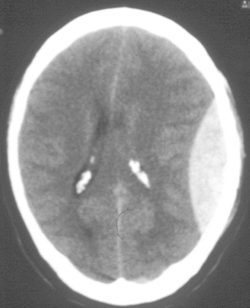“But Doc, I didn’t hit my head THAT hard”
Computed tomography (CT) scans are frequently performed after a head injury to rule out acute intracranial findings. However, most Emergency Department patients with a head injury have no acute CT findings. The Canadian CT Head Rule (CCHR) was developed to help clinicians determine when to order a CT image for patients with minor head injury.1 In 2010, a multi-centre prospective trial implemented the CCHR and found that the rate of CT imaging increased despite the use of the clinical decision rule.2 Of the many factors influencing this, the greatest seems to be that clinicians inappropriately apply the CCHR and may be unfamiliar with the inclusion and exclusion criteria. Of note, only head injury patients with a witnessed loss of consciousness (LOC), definite amnesia, or witnessed disorientation are included.1 The CCHR has been well studied and demonstrated high sensitivity for predicting injuries that require neurological intervention and reasonable specificity. 3–5
This Canadian CT Head Rule Tiny Tip was developed to aid emergency medicine clinicians to remember when to apply:
Avoid Driving if you Get SSmashed And Vomit

A CT Head is only required for minor head injury patients with any of these findings:
Medium Risk (for brain injury on CT)
A – Amnesia before impact ≥ 30 min
D – Dangerous mechanism (pedestrian struck by vehicle, occupant ejected from motor vehicle, fall from elevation > 3 feet or 5 stairs)
High Risk (for neurological intervention)
G – Glasgow Coma Score (GCS) score < 15 at 2 hours after injury
S – Suspected open or depressed skull fracture
S – Signs of basilar skull fracture (hemotympanum, “racoon” eyes, CSF otorrhea/rhinorrhea, battle’s sign)
A – Age ≥ 65 years
V – Vomiting ≥ 2 episodes
In addition to the risk factors, it is important to remember the inclusion and exclusion criteria so that the rule can be applied in the correct patients.
Inclusion Criteria:
- Minor head injury (blunt trauma to the head resulting in witnessed LOC, definite amnesia, or witnessed disorientation)
- Initial ED GCS ≥ 13
- Injury within the past 24 hours
Exclusion Criteria:
- Age < 16 years
- Minimal head injury (no LOC, amnesia, or disorientation)
- Unclear history of trauma as the primary event (Ex: primary seizure or syncope)
- Obvious penetrating skull injury or depressed skull fracture
- Acute focal neurological deficit
- Unstable vital signs associated with major trauma
- Seizure prior to ED assessment
- Bleeding disorder or anticoagulation use
- Return for reassessment of the same head injury
- Pregnant
This post was copyedited by Jesse Leontowicz (@jleontow)
Reviewing with the Staff
The Canadian CT Head Rule is a safe and helpful rule to assess head injury patients to determine which patients require imaging. However, as with all clinical decision rules/scores, it needs to be applied correctly. Only apply this rule to patients with head injuries with GCS of 13-15 with one or more of: witnessed loss of consciousness, amnesia or confusion. Patients with bleeding disorders or who are on anticoagulants also should not be assessed with this rule.



